A Moment of Silence
September 11, 2003
Taconya D. Piper
NOAA Office of Ocean Exploration
Today, as we remember those lost on that tragic morning two years ago, we take time to celebrate life and freedom. As we reflect on the people and things that are most important to us, we are thankful to be granted an opportunity to share our knowledge and experiences with others. At 8:46 am this morning, everyone on board the NOAA Ship Ronald H. Brown paused for a moment of silence.
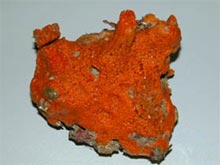
Our sought after bright orange Forcepia. After days of looking for this sponge, we finally found it during the first dive on Sept. 11. Click image for larger view.
A Walk Through "Forcepia-land"
September 11, 2003
Gary K. Wolfe
Marine and Environmental Education
Eau Gallie High School
Rollins College, Brevard, FL
Taconya D. Piper
NOAA Office of Ocean Exploration
![]() Video of Forcepia, not just your ordinary sponge. (mp4, 1.5 MB)
Video of Forcepia, not just your ordinary sponge. (mp4, 1.5 MB)
The site we all call "Forcepia-land" -- last visited by scientists from Harbor Branch Oceanographic Institution 15 yrs ago, in 1988 -- has a visitor once again. The ROV (remotely operated vehicle) Innovator is looking to bring back some of the local residents in the name of science. Since our first dive at this site, two days ago, we have been actively searching for Forcepia without much luck. Some members of the scientific party were concerned that a shrimp trawler might have come through and damaged the system, making the bright orange sponge difficult to locate. But today we finally located the elusive creature. When the ROV arrived back on the deck and the 5-gal collection buckets were escorted to the wet lab, everyone was eager to open the lids and see the prize. It was quite a funny sight. Even the captain of the NOAA Ship Ronald H. Brown commented on the scientists' excitement as they waited to open the buckets.
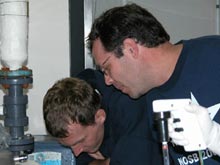
NOAA OE Expedition Coordinator Jeremy Potter (l) and Teacher at Sea Gary K. Wolfe (r) examine Forcepia sponges collected during the first dive on Sept. 11. Click image for larger view.
Yes, we had finally found our sought after Forcepia. They were beautiful. The fist-sized, bright orange sponges were perfect for the scientists to conduct all of their experiments. As it turned out, the scientists collected more than enough to conduct all of their studies. Many experiments are being performed on the Forcepia while we are at sea. From cell isolation and culture to DNA extraction and other microbiological tests, there is enough work to keep everyone busy for the next few hours. Not only did we collect enough Forcepia to conduct all of the experiments, we also collected bryozoans and ascidians.
Jeremy Potter, the NOAA Ocean Explorer expedition coordinator, and I had the opportunity to get our hands wet and learn how to prepare the sponge for experimentation. Wearing rubber gloves so I would not contaminate the sponge, I assisted Dr. Sherry Pomponi in the extraction of live sponge cells. From my perspective, it was very interesting and gave me a better sense of what the mission was about. After all, one of the objectives of the Teacher-at-sea program is to expose educators to working research science.
Many more hours of work are needed to get the desired results, and all of the scientists are working extremely hard. Microbiology is a very precise science, and all experiments require careful preparation. The slightest error during any step could render undesirable results.
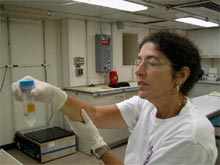
Dr. Shirley Pomponi isolates pure Forcepia cells for culture. This image shows the solution of cells before being placed in a centrifuge. The Forcepia cells are orange and on top; the clear density gradient used to separate the sponge cells from other cells found in the sponge is on the bottom. Click image for larger view.
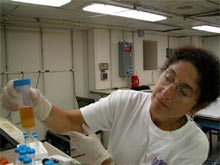
This image shows the solution after it is placed in a centrifuge. You can see the distinction between the sponge cells (orange) and the density gradient (clear) used during the process. The density gradient is used to separate fungi and bacteria cells from the sponge cells. The less dense cells float to the top of the tube, and the denser cells fall to the bottom. Dr. Pomponi wants only sponge cells and will remove all other cells before culturing. Click image for larger view.
A few hours after the samples from the first dive were collected and processed, the ROV was back in the water on a mission to find more sponges. On this dive, it collected organisms including Mycalie, Stelletida, Axinellida, the Gorgonia Swiftia sp., and a Choristida with spicules so sharp they broke through the two pairs of gloves I was wearing.
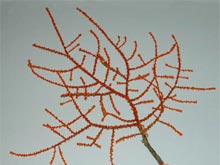
This gorgonian (Swiftia sp.) was collected during the second dive on Sept. 11. Click image for larger view.
The science party, Sonsub Inc.'s ROV pilots and technicians, and the C&C technicians have been working extremely hard to make sure that each dive is successful. Their professionalism combined with many levels of expertise have made this mission great. The ROV pilots and technicians have perfected their sampling and handling techniques so that it seems as if they collect marine organisms all the time. With more work ahead of them, the Harbor Branch scientists hope that "Forcepia-land" will yield cancer-fighting compounds that will improve the quality of life for millions.
Sign up for the Ocean
Explorer E-mail Update List.





















